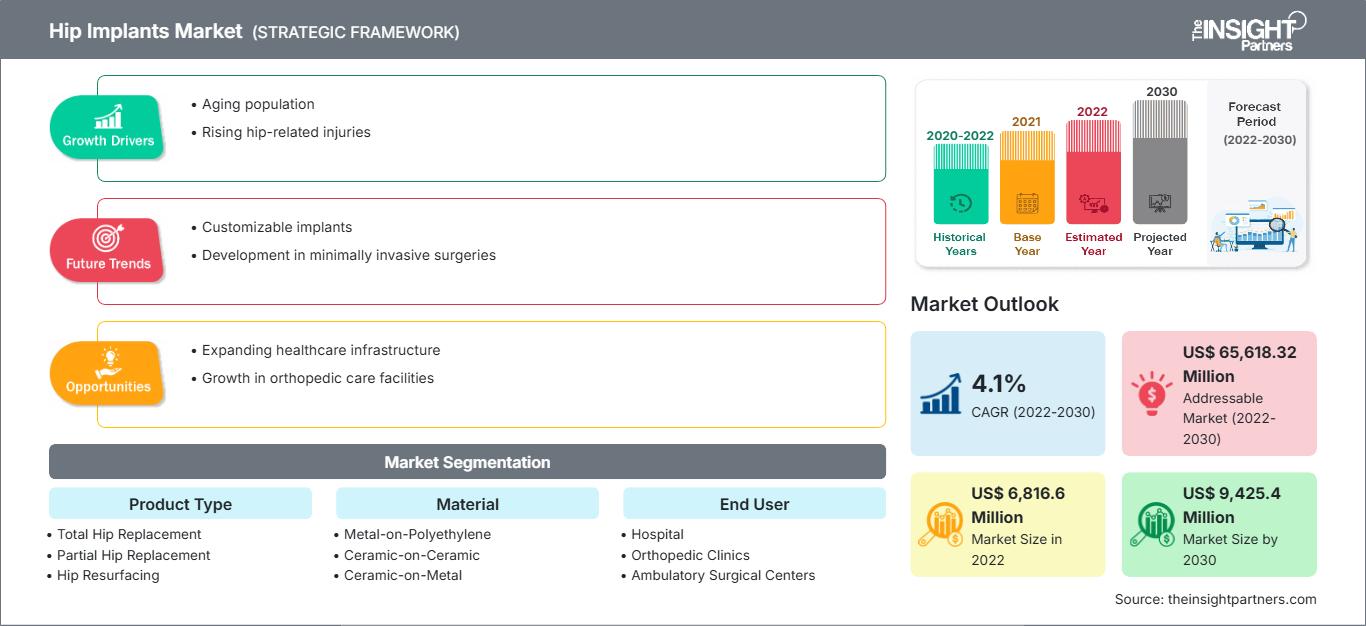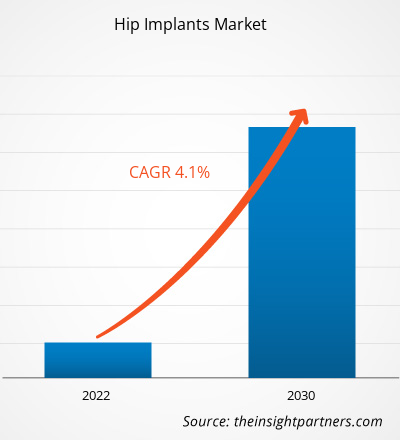[Informe de investigación] Se prevé que el mercado de implantes de cadera crezca de 6.816,6 millones de dólares estadounidenses en 2022 a 9.425,4 millones de dólares estadounidenses en 2030; se anticipa que registre una tasa de crecimiento anual compuesta (TCAC) del 4,1% entre 2022 y 2030.
Perspectivas del mercado y opinión de los analistas:
El mercado de implantes de cadera está creciendo rápidamente debido al aumento de las cirugías de cadera, las lesiones de cadera, la osteoartritis y la artritis reumatoide. Además, las iniciativas estratégicas de las empresas para mantenerse competitivas impulsan este crecimiento. Por ejemplo, Smith & Nephew lanzó el sistema OR3O Dual Mobility en India en agosto de 2023 para artroplastia de cadera primaria y de revisión. El OR3O incorpora la avanzada superficie de apoyo OXINIUM DH de Smith & Nephew, gracias a su revestimiento y a la tecnología patentada OXINIUM sobre XLPE. Esto elimina tanto el revestimiento modular de CoCr como la cabeza femoral de CoCr, reduciendo así los riesgos de desgaste y corrosión asociados a la aleación. Por lo tanto, es probable que un aumento significativo en las tecnologías revolucionarias para satisfacer las necesidades de los clientes genere nuevas tendencias en las previsiones del mercado de implantes de cadera.
Factores de crecimiento y desafíos:
Según la Alianza para la Acción contra la Osteoartritis, la osteoartritis es una de las formas más comunes de artritis en Estados Unidos, afectando a casi 32,5 millones de personas, de las cuales el 43% tenía más de 65 años en 2020. De acuerdo con los Centros para el Control y la Prevención de Enfermedades (CDC), alrededor del 23% de la población estadounidense padecía artritis en 2020. Según Arthritis Research Canada, se estima que más de 6 millones de canadienses tienen osteoartritis, cifra que se proyecta que alcance los 10,5 millones para 2040. La osteoartritis puede provocar lesiones y fracturas de cadera, ya que la densidad ósea en pacientes con artritis es menor que en quienes no la padecen.
La Organización Mundial de la Salud (OMS) estimó que la población mayor de 60 años era de mil millones en 2019, cifra que se prevé alcance los 1400 millones en 2030 y los 2100 millones en 2050. Se pronostica que la proporción de población geriátrica aumentará de aproximadamente el 15 % al 24 % durante este período. Según otro informe de Eurostat, Europa registró el mayor porcentaje mundial (20,8 %) de personas mayores de 60 años en 2021. Además, para 2050, en todas las regiones, excepto África, más del 25 % de su población habrá superado los 60 años. Por lo tanto, el aumento de la población geriátrica ha incrementado la prevalencia de diversas afecciones ortopédicas, como lesiones de cadera, artrosis y luxaciones de cadera por caídas y otros accidentes, lo que ha impulsado el crecimiento del mercado de implantes de cadera.
Obtendrá personalización gratuita de cualquier informe, incluyendo partes de este informe, análisis a nivel de país y paquetes de datos de Excel. Además, podrá aprovechar excelentes ofertas y descuentos para empresas emergentes y universidades.
Mercado de implantes de cadera: Perspectivas estratégicas

-
Obtenga las principales tendencias clave del mercado que se describen en este informe.Esta muestra GRATUITA incluirá análisis de datos, que abarcarán desde tendencias de mercado hasta estimaciones y pronósticos.
Segmentación y alcance del informe:
El mercado de implantes de cadera se divide según el tipo de producto, el material, el usuario final y la geografía. Por tipo de producto, se segmenta en reemplazo total, reemplazo parcial, recubrimiento de cadera y revisión de implantes de cadera. Por material, se segmenta en metal sobre polietileno, cerámica sobre cerámica, cerámica sobre metal, cerámica sobre polietileno y otros. Por usuario final, se segmenta en hospitales, clínicas ortopédicas, centros quirúrgicos ambulatorios y otros. Geográficamente, se divide en Norteamérica (Estados Unidos, Canadá y México), Europa (Reino Unido, Alemania, Francia, Italia, España, Rusia y el resto de Europa), Asia Pacífico (China, Japón, India, Corea del Sur, Australia y el resto de Asia Pacífico), Oriente Medio y África (Emiratos Árabes Unidos, Arabia Saudita, Sudáfrica y el resto de Oriente Medio y África) y Sudamérica y Centroamérica (Brasil, Argentina y el resto de Sudamérica y Centroamérica).
Análisis segmentario:
El análisis del mercado de implantes de cadera, por tipo de producto, se segmenta en reconstrucción femoral, reconstrucción acetabular, recubrimiento de la superficie articular de la cadera, implantes de revisión de cadera, tecnologías de rodamientos y metal poroso, e implantes de reemplazo total. En 2022, el segmento de implantes de reemplazo total ostentó la mayor cuota de mercado y se prevé que registre la mayor tasa de crecimiento anual compuesto (TCAC) durante el período 2022-2030.
Por material, el mercado se segmenta en metal sobre polietileno, cerámica sobre cerámica, cerámica sobre metal y cerámica sobre polietileno. En 2022, el segmento de metal sobre plástico ostentó la mayor cuota de mercado de implantes de cadera y se prevé que registre la mayor tasa de crecimiento anual compuesto (TCAC) en el pronóstico del mercado de implantes de cadera entre 2022 y 2030. El crecimiento de este segmento se debe a ventajas como la precisión, la durabilidad y la rentabilidad. Además, otros beneficios, como la menor incidencia de complicaciones, los avances tecnológicos y la menor generación de partículas de desgaste, impulsan la demanda de implantes de cadera de metal sobre plástico.
Por usuario final, el mercado se segmenta en hospitales, clínicas ortopédicas, centros quirúrgicos ambulatorios y otros. En 2022, el segmento hospitalario ostentó la mayor cuota de mercado de implantes de cadera y se prevé que registre la mayor tasa de crecimiento anual compuesto (TCAC) entre 2022 y 2030. El creciente número de cirugías de implantes de cadera en hospitales impulsa el crecimiento de este segmento a nivel mundial. Además, el personal hospitalario está bien capacitado y conoce las posibles complicaciones que pueden surgir durante o después de la cirugía. El personal está entrenado para atender emergencias y brindar una atención integral al paciente. Los procedimientos de reembolso para las cirugías son accesibles y pueden ser gestionados por la administración hospitalaria. Asimismo, es probable que el creciente número de hospitales a nivel mundial mantenga el dominio del segmento y potencie el crecimiento del mercado de implantes de cadera durante el período de pronóstico.
Análisis regional:
Geográficamente, el informe de mercado de implantes de cadera se divide en Norteamérica, Europa, Asia Pacífico, Oriente Medio y África, y Sudamérica y Centroamérica. Norteamérica es el principal contribuyente al crecimiento del mercado mundial de implantes de cadera. Se prevé que Asia Pacífico registre la mayor tasa de crecimiento anual compuesto (TCAC) en el mercado de implantes de cadera entre 2022 y 2030. El aumento de la incidencia de implantes de cadera, los lanzamientos de productos y las lesiones deportivas de cadera impulsan principalmente el crecimiento del mercado en Estados Unidos. Según el artículo «Atención a las fracturas de cadera y sistemas nacionales», publicado por Wolters Kluwer Health, Inc., entre 250 000 y 300 000 personas en Estados Unidos son hospitalizadas anualmente por fracturas de cadera. Se estima, además, que para 2040 unas 500 000 personas recibirán atención médica por fracturas de cadera. Según la Academia Estadounidense de Cirujanos Ortopédicos, las personas mayores de 65 años son propensas a sufrir fracturas de cadera debido a caídas en el hogar o en la comunidad en Estados Unidos. Según el artículo «Panorama general de la cadera», publicado en la Biblioteca Nacional de Medicina, los pacientes gastan aproximadamente 40 000 dólares estadounidenses durante el primer año tras una fractura de cadera, y el coste total de la atención a las fracturas de cadera en Estados Unidos asciende a casi 17 000 millones de dólares anuales. Por lo tanto, la creciente prevalencia de fracturas y lesiones de cadera en Estados Unidos, junto con el aumento del gasto en el tratamiento de estas lesiones, constituyen la tendencia actual del mercado de implantes de cadera en dicho país.
Perspectivas regionales del mercado de implantes de cadera
Los analistas de The Insight Partners han explicado en detalle las tendencias y los factores regionales que influyen en el mercado de implantes de cadera durante el período de previsión. Esta sección también analiza los segmentos del mercado de implantes de cadera y su distribución geográfica en Norteamérica, Europa, Asia Pacífico, Oriente Medio y África, y Sudamérica y Centroamérica.
Alcance del informe de mercado de implantes de cadera
| Atributo del informe | Detalles |
|---|---|
| Tamaño del mercado en 2022 | 6.816,6 millones de dólares estadounidenses |
| Tamaño del mercado para 2030 | US$ 9.425,4 millones |
| Tasa de crecimiento anual compuesto global (2022 - 2030) | 4,1% |
| Datos históricos | 2020-2022 |
| período de previsión | 2022-2030 |
| Segmentos cubiertos |
Por tipo de producto
|
| Regiones y países cubiertos |
América del norte
|
| Líderes del mercado y perfiles de empresas clave |
|
Densidad de los participantes en el mercado de implantes de cadera: comprensión de su impacto en la dinámica empresarial
El mercado de implantes de cadera está creciendo rápidamente, impulsado por la creciente demanda de los usuarios finales debido a factores como la evolución de las preferencias de los consumidores, los avances tecnológicos y una mayor conciencia de los beneficios del producto. A medida que aumenta la demanda, las empresas amplían su oferta, innovan para satisfacer las necesidades de los consumidores y aprovechan las nuevas tendencias, lo que impulsa aún más el crecimiento del mercado.

- Obtenga una visión general de los principales actores del mercado de implantes de cadera.
Desarrollos de la industria y oportunidades futuras:
A continuación se enumeran varios planes de los principales actores que operan en el mercado de implantes de cadera:
- En agosto de 2022, Exatech lanzó al mercado un innovador sistema de artroplastia total de cadera compuesto por el vástago Spartan y la copa Logical. El vástago Spartan responde a las necesidades actuales de los pacientes y a los últimos avances en técnicas quirúrgicas. La copa Logical es un sistema acetabular modular de última generación diseñado para satisfacer las exigencias de pacientes muy activos, a la vez que permite un procedimiento quirúrgico eficiente en hospitales y centros quirúrgicos ambulatorios.
- Smith & Nephew lanzó el sistema OR3O Dual Mobility en septiembre de 2022 para artroplastia de cadera primaria y de revisión en Japón. Esta avanzada superficie de apoyo, OXINIUM DH, se utiliza por su tecnología OXINIUM lineal y patentada sobre XLPE para sus insertos de polietileno y la cabeza femoral.
Panorama competitivo y empresas clave:
Algunos de los principales actores del mercado de implantes de cadera que se analizan en el informe son Smith & Nephew, Exactech, Zimmer Biomet, Stryker Corporation, DJO Surgical (Enovis), Medacta, Conformis, DePuy Orthopaedics, MicroPort Orthopedics y Symbios. Estas empresas se centran en la expansión geográfica y el lanzamiento de nuevos productos para satisfacer la creciente demanda de los consumidores a nivel mundial y ampliar su gama de productos especializados. Su presencia global les permite atender a una amplia base de clientes, lo que facilita la expansión del mercado.
- Análisis histórico (2 años), año base, pronóstico (7 años) con CAGR
- Análisis PEST y FODA
- Tamaño del mercado, valor/volumen: global, regional y nacional
- Industria y panorama competitivo
- Conjunto de datos de Excel
Informes recientes
Informes relacionados
Testimonios
Razón para comprar
- Toma de decisiones informada
- Comprensión de la dinámica del mercado
- Análisis competitivo
- Información sobre clientes
- Pronósticos del mercado
- Mitigación de riesgos
- Planificación estratégica
- Justificación de la inversión
- Identificación de mercados emergentes
- Mejora de las estrategias de marketing
- Impulso de la eficiencia operativa
- Alineación con las tendencias regulatorias






















 Obtenga una muestra gratuita para - Mercado de implantes de cadera
Obtenga una muestra gratuita para - Mercado de implantes de cadera